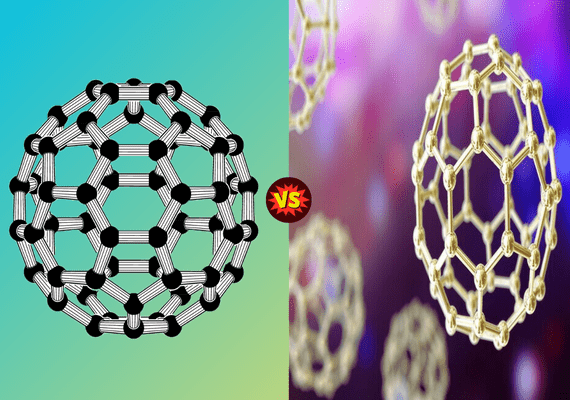Introduction
Nanomaterials and Nanoparticles operate at the nanoscale, typically within the range of 1 to 100 nanometers, exhibiting unique properties distinct from their bulk counterparts.
In the realm of science and technology, the exploration of the nanoscale world has been a testament to the adage, “smaller can be better.” Enter the fascinating domain of nanomaterials and nanoparticles, where size truly matters, and where properties change as materials shrink to dimensions typically ranging from 1 to 100 nanometers (nm).
Nanomaterials and nanoparticles are at the frontier of modern research, driving innovations across diverse fields, from electronics to medicine.
At this scale, substances exhibit novel and enhanced properties, distinct from their macro-scale counterparts. These unique attributes are largely a result of the increased surface area relative to volume and quantum mechanical effects that become pronounced at such small scales.
Nanomaterials broadly refers to materials that possess at least one dimension in the nanoscale, whereas nanoparticles are typically defined by having all three dimensions within the nanoscale. The distinction, while subtle, leads to a wide array of applications and potential for both.
The science of the very small has promised transformative breakthroughs, and as we delve deeper into this article, we will explore the intricacies, applications, and potential of these nano-entities.
Definition of Nanomaterials
Nanomaterials are materials characterized by their nanoscale dimensions, specifically having at least one external dimension in the size range of approximately 1-100 nanometers (nm).
This dimensionality can manifest in various forms, be it in thickness (like 2D materials such as graphene), diameter (as in the case of nanowires or nanotubes), or pore size (like in nanoporous materials).

What differentiates nanomaterials from bulk materials is that their properties often differ significantly from those of their macroscopic counterparts due to the increased relative surface area and quantum effects.
Nanomaterials can be naturally occurring (like volcanic ash) or engineered for specific applications (like nanoparticles embedded in a matrix). They can consist of a variety of components, including metals, semiconductors, or organic compounds.
Definition of Nanoparticles
Nanoparticles are a subset of nanomaterials but are defined strictly based on their size particles with all three external dimensions in the 1-100 nm range. Due to their small size, they exhibit properties that are not seen in larger particles of the same material.

This includes increased reactivity, altered electronic properties, and unique optical behaviors. Nanoparticles can be spherical, tubular, or even irregular in shape.
They can exist independently or be constituents in a larger nanomaterial structure. Examples include gold nanoparticles, carbon nanotubes, and liposomes.
What are the types of Nanoparticles and Nanomaterials?
Nanoparticles:
1. Metallic Nanoparticles
- Examples: Gold (Au), Silver (Ag), Iron (Fe), Platinum (Pt) nanoparticles, etc.
2. Metal Oxide Nanoparticles
- Examples: Titanium dioxide (TiO2), Zinc oxide (ZnO), Iron oxide (Fe3O4), Silicon dioxide (SiO2), etc.
3. Semiconductor Nanoparticles (Quantum Dots)
- Examples: Cadmium selenide (CdSe), Cadmium telluride (CdTe), etc.
4. Carbon-based Nanoparticles
- Fullerenes: Spherical molecules made of carbon, like C60
- Carbon dots: Fluorescent carbon nanoparticles
5. Polymeric Nanoparticles
- Examples: PLGA (poly(lactic-co-glycolic acid)) nanoparticles, dendrimers, etc.
6. Lipid-based Nanoparticles
- Liposomes: Spherical vesicles with a lipid bilayer
- Solid lipid nanoparticles: Lipid matrix in solid state at room temperature
- Nanoemulsions: Droplets stabilized by surfactants
7. Biodegradable Nanoparticles
- Examples: Protein-based, starch-based nanoparticles, etc.
8. Magnetic Nanoparticles
- Examples: Iron oxide nanoparticles like magnetite (Fe3O4) and maghemite (γ-Fe2O3)
9. Ceramic Nanoparticles
- Examples: Silica, alumina, etc.
Nanomaterials:
1. Carbon-based Nanomaterials
- Carbon Nanotubes (CNTs): Single-walled (SWCNTs) and multi-walled (MWCNTs)
- Graphene: A single layer of carbon atoms arranged in a hexagonal lattice
- Graphene oxide: Graphene oxide (GO) and reduced graphene oxide (rGO)
2. Nanostructured Materials
- Nanowires: High-aspect-ratio, often semiconductor-based
- Nanorods: Similar to nanowires but shorter in length
- Nanobelts: Thin, flat, elongated materials
3. Nanocomposites
- Combination of two or more different types of materials at the nanoscale, e.g., polymer matrix with embedded nanoparticles.
4. Nanofibers
- Created using techniques like electrospinning; used in tissue engineering, drug delivery, etc.
5. Layered Double Hydroxides (LDH)
- Stacked anionic clay materials
6. Quantum Dots
- Semiconductor crystals with size-dependent properties.
7. Nanosheets or Nanoplates
- Flat, often two-dimensional materials with one dimension in the nanoscale
8. Aerogels and Xerogels
- Highly porous materials with a large surface area, created by replacing the liquid component of a gel with a gas (aerogel) or by evaporation (xerogel)
9. Nanosponges
- Polymeric structures are designed to encapsulate and release substances.
Properties
Properties of Nanoparticles
1. High Surface Area to Volume Ratio:
- Because of their tiny size, a significant portion of their atoms or molecules exists on the surface. This characteristic leads to enhanced reactivity, making nanoparticles suitable for applications like catalysis.
2. Quantum Effects:
- Quantum confinement can lead to changes in properties like electronic, optical, and magnetic behaviors. For example, quantum dots are nanoparticles that have size-dependent optical properties, making them valuable for imaging and display technologies.
3. Optical Properties:
- Some nanoparticles show unique optical phenomena due to their nanoscale dimensions, like localized surface plasmon resonance (LSPR) in gold nanoparticles.
4. Magnetic Properties:
- Certain nanoparticles exhibit superparamagnetism, where they can be magnetized in the presence of a magnetic field but lose this magnetization when the field is removed. This property is utilized in data storage and biomedical applications.
5. Enhanced Strength and Hardness:
- Some nanoparticles, when incorporated into materials, can enhance the material’s strength and hardness.
Properties of Nanomaterials
1. Enhanced Mechanical Properties:
- Nanomaterials like carbon nanotubes are known for their incredible strength and flexibility.
2. Electrical Conductivity:
- Materials like graphene exhibit high electrical conductivity, opening doors for various electronic applications.
3. Thermal Properties:
- Some nanomaterials can effectively conduct heat, making them suitable for thermal management in electronics.
4. Responsiveness to Stimuli:
- Nanomaterials can be designed to respond to external stimuli like pH, temperature, or light. Such materials find applications in drug delivery and sensors.
5. Porosity:
- Nanoporous materials have pores with diameters less than 100 nm. This property makes them suitable for applications like gas storage, catalysis, and filtration.
6. Multi-functionality:
- By combining different nanoparticles, nanomaterials can be designed to have multiple functionalities. For instance, a nanomaterial could be magnetic and fluorescent at the same time, making it suitable for simultaneous imaging and drug delivery in biomedical applications.
Key Difference Between Nanomaterials and Nanoparticles
Comparison Between Nanomaterials and Nanoparticles:
| Feature/Aspect | Nanomaterials | Nanoparticles |
|---|---|---|
| Definition | Materials with at least one external dimension in the 1-100 nm range. | Particles with all three external dimensions in the 1-100 nm range. |
| Composition | Can consist of a single type or a combination of nanoparticles or other nanostructures. | Typically consists of a single type of material, but can have core-shell or multi-layered structures. |
| Dimensionality | Can be one-dimensional, two-dimensional, or three-dimensional. | Strictly three-dimensional in the nanoscale range. |
| Properties | Arise from the collective behavior of the nanostructures within. | Unique properties arise primarily from their small size. |
| Examples | Carbon nanotubes, graphene, nanoporous silica. | Gold nanoparticles, quantum dots, liposomes. |
| Use Cases | Electronics, energy storage, structural composites. | Drug delivery, catalysis, imaging, cosmetics. |
Challenges and Concerns
The burgeoning field of nanotechnology, encompassing nanomaterials and nanoparticles, promises transformative solutions for various sectors, including medicine, energy, and electronics. Yet, as with any technological advancement, it presents challenges and concerns, both technical and ethical.
Environmental and Health Impacts
- Biodistribution & Toxicity: Some nanoparticles, once introduced into the body—either unintentionally or for medical purposes—can accumulate in specific organs, possibly leading to toxic effects. The small size allows them to bypass natural barriers, like the blood-brain barrier.
- Environmental Concerns: The environmental impacts of nanoparticles, especially if released in significant amounts, are not fully understood. There are concerns about their potential bioaccumulation and impact on the ecosystem.
Technical Challenges
- Scalable Production: While producing nanoparticles in a lab setting is feasible, scaling up these processes for industrial production while maintaining consistency can be challenging.
- Stability: Some nanomaterials are unstable and can aggregate or degrade over time, losing their desired properties.
Regulatory and Standardization Issues
- Lack of Standards: The field is rapidly evolving, and standardized methods for characterizing and producing nanoparticles are still in development.
- Regulatory Gaps: There’s a need for regulations that specifically address the unique properties and potential risks of nanomaterials, given their divergence from bulk materials.
Ethical and Societal Concerns
- Inequity in Access: As with many technological advancements, there’s a risk that the benefits of nanotechnology may not be evenly distributed, leading to further societal disparities.
- Privacy Issues: Some potential applications of nanotechnology, like advanced surveillance or data storage techniques, could raise privacy concerns.
Economic Challenges
- High Costs: Initial research, development, and production of nanomaterials can be expensive, which may translate to higher costs for the end consumer.
- Market Acceptance: Public misconceptions or fears about nanotechnology can hinder market acceptance of products that incorporate nanoparticles.
Interdisciplinary Nature of the Field
- Collaborative Challenges: Nanotechnology spans multiple disciplines, from biology and chemistry to engineering. Effective collaboration across these disciplines is crucial but can be challenging due to differing terminologies, methodologies, and perspectives.
Beyond the Basics: The Future Outlook
The difference between nanomaterials and nanoparticles is more than just semantics. Understanding this distinction is crucial as we delve deeper into the world of nanotechnology.
As research continues, there’s potential for discovering novel nanomaterials and nanoparticles with unprecedented properties, unlocking new applications and solutions for pressing global challenges.
While the promises are vast, it’s equally essential to tread with caution. Regulatory frameworks, ethical considerations, and extensive safety assessments should go hand in hand with technological advancements to ensure that the benefits of nanotechnology are realized without compromising human health or the environment.
Ending
The potential of nanomaterials and nanoparticles is vast, spanning sectors from healthcare to electronics. This promise comes with challenges.
Health and environmental impacts remain a concern, with uncertainties about long-term effects and bioaccumulation. Technically, scalable production and stability of these materials pose hurdles.
The rapid advancement of the field has outpaced the development of standardized regulations, leading to potential regulatory gaps. Ethically, there are worries about equitable access to nanotechnological benefits and potential privacy breaches.
Economically, high initial costs and public apprehension can be barriers to widespread adoption. Lastly, the interdisciplinary nature of nanotechnology, while a strength, can lead to collaboration challenges across diverse scientific domains.

